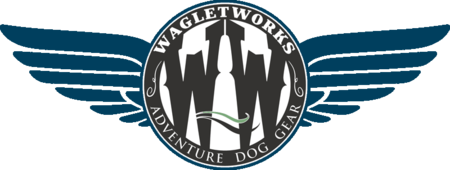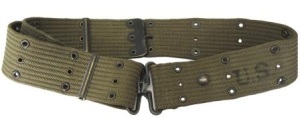by: Jason M. Grossman
(c) 2015 Waglet Works, LLC
The pistol belt has a long and storied history of distinguished use by the military. Beginning in 1910, the U.S. Army infantry Board set forth the first set of standardized military gear. The equipment was made from readily available materials, such as webbing and canvas duck. The system was built around a central element – the pistol belt, and designed to distribute the weight of a soldier’s equipment evenly. Pistol belts featured evenly-spaced grommets that allowed holsters and other equipment to be suspended from the belt. It was originally intended for officers, tank crews and others that often carried pistols instead of rifles.
The pistol belt, along with the other items in this system became known to the military as the M-1910 system. Equipment, including pistols, ammo, knives, canteens, intrenching tool and more could be clipped to the belt and/or suspenders. As new equipment was developed and introduced to military forces, the M-1910 was upgraded over the years, resulting in the M-1912, M-1923, M-1918, M-1928, M-1936, M-1938, M-1941 (often used by WWII-era Marines), M-1942, M-1943, M-1944 and M-1945 variants, but it’s core components remained in use until the development of the M-1956 system. The M-1936 variant was very popular with infantry troops in the early years of WWII, while the M-1943 variant was heavily in use towards the end of the war. The M-1956 introduced cotton to the fabric mix and was heavily used by American military forces throughout the Korean War and the beginning of the Vietnam War (alongside the updated M-1967 variant).
The M-1956 System
ALICE Enters the Army
As all wars do, the Vietnam war brought along it share of advances in technologies, as well as in modern warfare techniques, and gave rise to the next generation of belt-based systems. Needing a system to handle both a “fighting load” as well as a “existence load”, a newer, updated system was developed in the early 1970’s. Adopted by the U.S. Army in January of 1973, ALICE (short for All-Purpose Lightweight Individual Carrying Equipment), quickly became standard issue equipment for troops. it was designed for use in almost any environment. A true workhorse of the U.S. military, the ALICE system can still be found in limited use today by the National Guard, Marines, Navy and Air Force.
…And Along Comes Molle
1997 brought a new girl to the modern warfare table. MOLLE (pronounced Molly) stands for Modular Lightweight Load-carrying Equipment, made with military-grade Cordura fabric. Developed jointly by NATO forces, the MOLLE system has become the standard for most armies, especially the United States, British and Australian armies, as well as some police tactical units. Though developed and introduced in 1997, it entered widespread use during the Afghanistan and Iraq Wars. The United States Marine Corps adopted a new design in 2004 – the ILBE, or “Improved Load Bearing Equipment”. The Marines have since replaced the ILBE system with the newer “USMC Pack”.
Throughout all of these upgrades and variations, one constant has remained – the utility belt remains the core of the system. Efficient, lightweight and durable, it has faithfully serviced our troops’ ever-changing needs since 1910. Just for perspective, 1910 was the same year that William Taft was President of the United States, the the Boy Scouts of America was founded and Henry Ford’s little company hit the 10,000 car milestone.
Non-Military Uses for Utility Belts
Everyone knows Batman’s famed utility belt (which was a crafty combination of the military and police belts in use at the time), and of course they were used in reenactments and war films, but did you know that they have been in constant use behind the scenes of almost every movie, television show, concert or play you’ve ever seen? Soldiers making their way home from a war brought with them their ever-useful pistol belts and quickly adapted them for use outside of the military. A slew of returning veterans in Los Angeles found work in movie and television production and set-building. On a Hollywood set, the behind the scenes crew must often keep their hands free, but have quick access to the tools of their trade. These film workers were some of the earliest to use these belts to carry tools, walkie-talkies and other essential gear on set. They were also extremely easy to procure from WWII, Korean War and Vietnam War surplus stockpiles and quickly was adopted by many involved in film production.
Enter Artie Malesci and Barbara Peterson-Malesci, a famed film production team with decades of experience (as a stunt coordinator/director and set designer, respectively). Barbara and Artie have worked on a slew of big budget productions, ranging from Wild, Wild West to Marley and Me to Burn Notice. They always carry the gear they needed for their craft on their belts. After working long hours on set, they’d often return home with their belts. Once home, they would still need to walk their four German Shepherds before settling down for the evening. As many a dog owner knows, walking four big beasts is no easy task (especially when the owner is exhausted!). You need to carry four leashes, poop bags, a flashlight and more to accomplish this seemingly Herculean task. In a moment of brilliant clarity, Barbara decided to use her belt to help reduce her load and keep her hands-free, just like she does on a film production set.
Flush with ideas, and armed with a sewing machine and an ample supply of canvas fabric, she quickly stitched up some prototypes, including a poop transport bag that could carry both empty bags as well as filled ones (that she could dispose of at her leisure). After some extensive field testing, Barbara and Artie filed for patents on their new dog walking gear and created Waglet Works, a company dedicated to creating dog adventure gear based around a variation of the belts they wore in their other careers. Nowadays, you can find their gear in several pet boutiques and their online store: waglet.com, which carries a wide array of accessories and kits for adventuring with your dog (or just plain ol’ dog walks!).
We hope you’ve enjoyed this look at a humble little tool that has truly earned its rightful place in history. Have you ever used a pistol belt for purposes not listed in this post? If so, we’d love to hear your stories. Please feel free to email us or add your comments below.
About the Author
M. Grossman is an amateur history buff, inventor, blogger and entrepreneur. In addition to collecting vintage signs and guitars, Mr. Grossman is the owner of K9 Field Kits and the Co-Owner of Fuji and Friends Apparel Co. He currently resides in Miami with his pack of ridiculously over-sized dogs and one tiny little cat.





